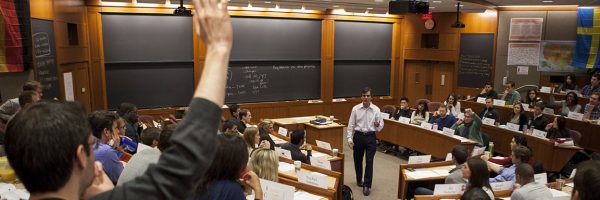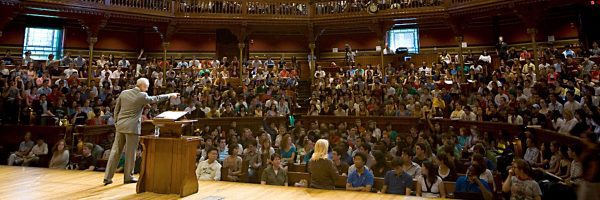Harvard Black Business Leaders Series Celebrates Black History Month

To commemorate Black History Month, Harvard Business School presented a series of cases, courses, and podcasts highlighting influential black business leaders. Within its MBA curriculum, HBS has also been working to increase the representation of compelling African-American protagonists culled from a wide range of industries in the case studies at the heart of its distinctive case study method.
Senior Lecturer Steven Rogers (no not that one), who teaches the course “Black Business Leaders and Entrepreneurship,” was one of the catalysts for this initiative. Rogers uses his course as an opportunity to honor the unsung impact that many African-American business leaders have had on the way America does business. As part of the Black Business Leaders Series of podcasts, Rogers interviews living African-American leaders about the dizzying highs and devastating lows of doing business.
John Rogers Podcast
One such interview features Ariel Investments Founder, Chairman, and CEO John Rogers (no relation), whose financial management firm handles about $13.1 billion. Ariel currently has 90 employees and considers itself a miniature version of Fidelity. “John Rogers is one of America’s great entrepreneurs,” says Steven Rogers by way of introduction. “In the words of Warren Buffett, he is one of the greatest investors of our time.”
The podcast delves into John’s vocal criticism of diversity in Fortune 500 companies and how his comments got him in trouble with his board. It also discusses such topics as a severe lack of inclusion present in the financial management industry. It’s a problem that impacts the entire sector, from job creation to community health.
“When African-American–owned companies are allowed to prosper and grow, we see the creation of more jobs,” Steven Rogers explained in the podcast. “When people have jobs, they’re self-sufficient. When people are self-sufficient, they live in healthy communities. That’s exactly what happens when diversity and inclusion is actualized and people like John are given a chance to grow their companies.”
To listen to the full podcast visit the school website.
Black Business Leaders Series Highlights
Don’t miss these other great podcasts in the HBS Black Business Leaders series:
- A discussion of Ebony Magazine, which for more than seven decades has chronicled the most important African-American issues and interests of the time.
- An interview with Senior Lecturer Henry Q. McGee on the topic of “The Black List” in Hollywood.
- An in-depth look at the legacy of Maggie Lena Walker and the Independent Order of St. Luke.
To access the complete Black Business Leaders Series, visit the HBS Newsroom.
This article has been edited and republished with permissions from our sister site, Clear Admit.
School v. School: Harvard Business School or MIT Sloan?

When selecting an MBA program, it can be difficult to cut through the fog to make the best long-term decision. For elite schools, the veil of prestige casts a long shadow. For lesser-known schools, it’s often a question of how much bang you’re getting for your buck. Allow our School v. School series to do the heavy lifting for you and present an in-depth comparison. Let’s consider the distinctions between Boston’s best: Harvard Business School and MIT Sloan.
Harvard Business School
Located in the Allston neighborhood of Boston, Harvard Business School’s 40-acre campus is “the only top business school in the United States with a self-contained, residential campus,” steps away from the downtown area of the city. HBS is famously one of the first MBA programs in the world. It also boasts one of the largest total student populations, with a grand total of 1,871 enrolled students.
HBS Full-Time MBA
For many, HBS is the crème de la crème of MBA programs. U.S. News and World Report ranks it as the best in the country. HBS offers only one type of MBA degree: full-time. The program lasts a typical two years, with the first summer break reserved for an internship or internships. Due to the large student body, incoming students are divided into groups of 90 who will take the same coursework for a year’s time. Each segment represents the diversity of the incoming class.
Why HBS?
- The FIELD Foundations program (Field Immersion Experience for Leadership Development) helps students develop an awareness of their leadership styles by interacting with their “team” through intimate workshops. The program, which intends to build emotional intelligence, is unique for its personalized approach to business training.
- The Case Method was first established as the primary method of instruction at HBS, and many students cite it as a highlight of their time at HBS. The Case Method puts students in the position of the decision makers by presenting scenarios written by HBS staff themselves.
- HBS offers six joint degree options for students looking to expand into additional fields, such as law, medicine, and engineering.
- HBS routinely tops MIT when it comes to domestic and global MBA rankings.
Harvard vs. MIT MBA Rankings
| Harvard Business School | MIT Sloan School of Management | |
|---|---|---|
| U.S. News & World Report (U.S.) | 1 | 4 |
| The Economist (Global) | 3 | 19 |
| Financial Times (Global) | 5 | 9 |
| Forbes (U.S.) | 3 | 8 |
| Bloomberg Businessweek (U.S.) | 1 | 3 |
What Is Missing?
- There’s a hefty price tag for a HBS education: estimated at $106,800 annually, including tuition, room and board, materials, and healthcare.
- Outside of the U.Ss, starting salaries for international positions tend to be lower, despite Harvard’s reputation in the States.
- Harvard’s employment rate after graduation trails slightly behind MIT: 91 percent vs. MIT’s 93 percent.
- Out of 273 faculty members at HBS, only 70 are women; about 25 percent.
MIT Sloan School of Management
Situated in nearby Cambridge, the Sloan School of Management campus is “surrounded by biotech companies, tech giants, startups, and research labs.” MIT Sloan has a compact center for its MBA students, which revolves around a newly built facility called E62. Here, you’ll find the entire faculty and most academic programs. Its population of full-time MBA students hovers around 800, while 500 additional students are completing alternative post-baccalaureate business degrees.
Sloan School of Management Programs
Unlike HBS, MIT Sloan offers three kinds of MBA programs: the two-year, full-time MBA degree; 20-month Executive degree; and 12-month Sloan Fellows Program. The full-time MBA degree stands out for its Sloan Innovation Period (SIP), a full-immersion learning experience that occurs in the middle of each semester. Students take a week-long hiatus from classes to attend lectures, travel abroad, visit host companies, and more.
Why Sloan?
- The Global Entrepreneurship Lab is one opportunity that MBA students shouldn’t miss. Students act as advisors for start-up companies in markets around the world, delivering insight on topics such as “strategic growth, new market entry, pricing, marketing, benchmarking, fundraising, and financial strategy.”
- The Leaders for Global Operations caters to students interested in a dual degree in Engineering and Business. This two-year curriculum “places students in research internships at elite partner companies.”
- Sloan’s MBA class is made up of a larger international student base compared to Harvard; 39 percent, as opposed to 35 percent at HBS. This isn’t a significant gap, but it does show MIT’s commitment to diversity.
What Is Missing?
- According to Forbes, Sloan has a lower median base salary after graduation at $125,000. HBS grads average around $135,000.
- Unlike the HBS environment, not all students on campus are earning full-time MBA degrees. If you’re someone who enjoys working with the same student body throughout your degree, prepare for a bit more cross-section here.
- The current tuition and full cost for the MIT Sloan MBA is slightly higher than HBS (regarding non-married single students with no children).
Harvard vs. MIT MBA Cost
| Harvard Business School | MIT Sloan School of Management | |
|---|---|---|
| Tuition | $73,440 | $74,200 |
| Full-Cost | $109,124 | $111,570 |
When all is said and done, both MBAs are extremely cutting-edge programs that any ambitious prospective b-schooler would salivate over. Both Harvard and MIT offer a similar urban setting, as they exist in the same tightly packed university community in Boston. Additionally, both have the same acceptance rate (11 percent). For a final push, be sure to read up on faculty leading the way both at Harvard and MIT.
Stanford Reigns Supreme on New Financial Times Global Ranking

INSEAD hoped to top the Financial Times MBA rankings for the third year in a row, but it wasn’t to be. The Stanford Graduate School of Business (GSB) gets top bragging rights this year, returning to the number-one spot it has held only once before, in 2012. INSEAD was knocked to number two, followed by the University of Pennsylvania’s Wharton School, which held steady at number three. London Business School (LBS) reclaimed some ground this year—coming in fourth—after a rare fall last year out of the top five. Harvard Business School (HBS), meanwhile, ranked fifth, its lowest showing since 2008.
Rounding out the top 10 this year were the University of Chicago Booth School of Business at sixth (up from ninth last year); Columbia Business School at seventh (unchanged from 2017); China’s CEIBS at eighth (up from 11th); MIT Sloan School of Management at ninth (up from 13th); and UC Berkeley’s Haas School of Business at 10th, (also up from 13th).
Perhaps the greatest victors of this year’s FT rankings were two-year MBA programs, which occupied nine out of the top 10 spots. More two-year programs moved up or maintained their position this year than moved down (31 compared to 21). In contrast, more one-year programs lost ground than gained this year (14 up, 21 down).
“It’s great to see the continued strength of the two-year MBA format in this year’s FT rankings, a format that allows for a truly transformational and immersive experience,” said Clear Admit Co-Founder Graham Richmond. “LBS’s move back into the top five isn’t surprising in light of the program’s continued strength in job placements, new facilities, curriculum redesign, and location at the heart of business and innovation in Europe (even as Brexit looms),” he continued. “While HBS’s position is inconsistent with Clear Admit’s Decision Wire-based data on applicant preferences, it’s the increasing gap in the FT ranking between Stanford and HBS that seems noteworthy.”
As always, the bearing a given ranking should have on your own choice of schools depends on how closely the methodology used to arrive at that ranking aligns with what you deem most important. So just how does the FT compile its list each year?
Understanding the FT Ranking Methodology
The FT ranking is based on surveys of alumni three years out from graduation, school data, and research rank. Alumni responses inform eight criteria—including average income three years after graduation and salary increase compared with pre-MBA salary. Together, these eight criteria account for 59 percent of the overall ranking. School data inform another 11 criteria—including various measures of diversity such as percentages of female and international faculty, students, and board members. Together these criteria make up another 31 percent of the ranking. The remaining 10 percent of the ranking is based on research rank, calculated according to the number of articles by full-time faculty in 50 internationally recognized journals, weighted relative to faculty size.
Record-Breaking Salaries Put Stanford GSB on Top
Stanford, which ranked second last year, managed to unseat INSEAD this year thanks in part to the record-breaking salaries reported by its alumni. The average Stanford alumnus salary three years after graduation was $214,742, up $20,000 over last year’s figures and the highest recorded since the inaugural FT ranking in 1999. Stanford grads’ average salary also represented a 114-percent gain on their pre-MBA salaries, also the highest increase among ranked schools. That a significant proportion of Stanford grads head into highly lucrative hedge fund positions helped it outdistance its rivals in this regard.
Stanford also far outdistanced its U.S. rivals in terms of the international exposure it affords its students. More than 25 percent of the latest graduating cohort did an internship abroad—compared to an average of 4 percent at ranked U.S. schools. Overall, though, Stanford ranked 32nd for international course exposure, down 14 places from last year. But in other measures of diversity, Stanford made gains, including its international faculty (41 percent), international board (25 percent), and international students (41 percent). In this last figure, too, Stanford set itself apart from its U.S. rivals, the majority of which have recruited fewer international students. Although the average proportion for ranked institutions is down by only one percentage point to 38 percent, the FT noted.
Research Scores Hold HBS, LBS Back
Both HBS and LBS saw their average salaries three years out increase by approximately $14,000—to $192,133 and $167,897 respectively. That climb helped LBS return to the top five this year, but sharp drops in each schools’ research ranks worked against them. Harvard’s research rank plummeted from third to 16th—contributing to its fall to fifth in the overall ranking. “This year’s research rank is based on articles published in 50 academic and practitioner journals by full-time faculty since January 2015, but several Harvard faculty last appeared in these publications in 2014, too long ago to count,” the FT noted. LBS, for its part, dropped from 12th to 27th in research rank.
Rice Business, Olin, Georgetown McDonough, Cornell Johnson See Big Gains
Just as two-year MBA programs fared well with regard to their one-year rivals this year, a select group of individual schools saw big gains this year over last. Rice University’s Jones School of Business jumped 19 places this year, from 64th to 45th. This surge can be attributed primarily to strong salary growth. Average salary grew from $130,189 to $139,189, contributing to a 118-percent increase over pre-MBA salary (up from 97 percent last year).
Washington University’s Olin Business School rose 18 spots, from 68th to 50th. The St. Louis school saw significant gains in average salary ($122,709) and increase over pre-MBA salary (107 percent). Georgetown University’s McDonough School of Business jumped 10 spots, from 40th to 30th, thanks also in part to increased average salary, as well as improved research rank (up 10 spots to 17th) and various diversity measures. And Cornell University’s Johnson Graduate School of Management also moved 10 spots up in the ranks, from 27th to 17th, due in great part to a significant increase in its research rank, up 13 places to fourth overall.
Spain’s Schools Slip Out of Top 10
In less celebratory news, two of Spain’s top-tier business schools slid out of the FT’s upper-most ranks. IESE slipped from 10th to 11th. Though its graduates’ average salary increased year over year, the increase was slight. Moreover, it slipped seven spots in terms of percentage increase over pre-MBA salary. Research rank, too, fell by five spots over the previous year.
IE Business School, meanwhile, fell out of the ranking altogether—from eighth last year. This is because it couldn’t gather a representative sample of the school’s alumni to take part in the FT’s survey.
As always, those of us here at Clear Admit encourage prospective applicants to use a school’s performance in these and other rankings as just one of many measurements to determine the MBA program that will best fit your individual needs.
You can view the complete Financial Times 2018 Global MBA Rankings here.
This article has been edited and republished with admissions from our sister site, Clear Admit.
More Harvard MBAs Are Turning to Politics

There’s no doubt that politics and public service have been hot topics since the November 2016 election. These subjects have dominated news stories and talk shows across the country. And, according to a recent report by the Wall Street Journal, politics and public service are also moving up as career choices for graduates from Harvard Business School (HBS).
Around 40 Class of ’17 HBS MBA graduates launched careers in government and nonprofits—twice as many as the previous year. Even though this represents just 4 percent of the program’s 900 graduates, it still suggests a growing interest in policy-making for business students.
Of course, business and government have always been closely connected, and it’s common for MBA students to aspire to public service and nonprofit involvement as part of their long-term career plans. The difference is that MBA graduates are starting to head into public service careers immediately after graduation. At least that’s what Matthew M. Segneri, an HBS MBA Class of 2004 alumnus, has witnessed.
Segneri, the director of the Social Enterprise Initiative at HBS, has noticed that graduates are increasingly considering careers in politics. In an article in the Harvard Crimson, he said: “Over the last 12 to 18 months, I’ve had a number of conversations with folks and seen a real uptick in the number of people who are thinking about local, state, and federal office.”
He went on to observe a change in the timing of these plans. “When you look at the prior generations of alumni there is more the tradition of learn, earn, and return—folks would go to school, have a successful traditional business career, and then later in life they would pursue public office or get deeply engaged in nonprofits and their communities,” Segneri said. “Today, there’s both an urgency and an understanding that it doesn’t have to be that way.”
There are many factors driving the surge in interest in politics. One is the simple fact that the United States elected a prominent businessman as president in the last election. Another is a trend of prominent business leaders being very vocal about politics in recent months, reinforcing the connection between the business and political realms.
For example, during the 2016 November election, Meg Whitman, the CEO of Hewlett Packard Enterprise Co., threw her support behind the Democratic candidate in New Jersey’s Fifth Congressional District race. And Carlos Diaz, a French entrepreneur in Silicon Valley, told the Financial Times that the tech industry has some responsibility for the 2016 election outcome.
YOU MAY ALSO LIKE: MBA Alumni Spotlight: HP CEO Meg Whitman
“The America that voted for Trump does not own a Tesla, nor an iPhone, and when it needs money, it does not ask business angels for help: it relies on bad credit,” Diaz said. “It is time to recognize that we need to develop technologies and businesses that will benefit the widest range of people possible, algorithms that do not divide but that bring together.”
So, it’s not a surprise that MBA graduates are heading into politics. In fact, more than a dozen Harvard MBA graduates have recently announced campaigns to run for local, state, or federal government.
Democrat Tim Keller, HBS MBA ’05, was elected mayor of Albuquerque, NM, last month while Republican Margaret Busse, HBS MBA ’01, recently announced her candidacy for the Massachusetts state senate. In addition, HBS MBA ’03 Sarah Amico is expected to announce her run for lieutenant governor in Georgia.
While Keller didn’t enter politics straight out of graduate business school, he understands why new MBA graduates are doing so. “In business school, what a lot of people do is say, ‘Oh, my second career is gonna be in public service. I’m gonna go into business, be successful, and then do public service,’” he told the Crimson. “What’s different all of a sudden is that people are opting out early, and they’re like ‘I’m gonna do this right now’ because they’re upset about something or fired up and want to make a difference.”
Adem T. Bunkeddeko, MBA Class of ’17, is currently running for Congress in New York’s Ninth Congressional District in Brooklyn—making him a perfect example of this phenomenon. Throughout his career at Harvard, Bunkeddeko maintained his connection to his local community and decided to use his business skills to better serve through politics. “At HBS we’re trained as general managers,” he said. “Understanding aspects of an organization, whether it be from the finance front or human capital, are important and useful skills that are actually quite lacking in public service today.”
And many other MBA graduates feel the same way. For Busse, who is running for the Massachusetts State Senate, the many case studies she read during her HBS coursework informed her desire to go into politics. “It’s really that ability to solve real-world problems that is needed in government today, that is needed in nonprofits today, and anywhere where people are trying to make a difference,” she said.
In addition, Busse sees widespread dissatisfaction with the current political climate as another reason MBA graduates are entering this arena. “I’m guessing a lot of people are feeling like me, frustrated with the current situation we have in politics today and feeling their skillset gives them a unique ability to help solve the problems we have right now,” Busse said.
In fact, that dissatisfaction led HBS MBA ’01 Daniella Ballou-Aares to recruit more HBS graduates into politics by forming the nonprofit Leadership Now with some of her fellow alumni. Developed after the 2016 election, Leadership Now recruits Harvard alumni and business leaders to run for office and helps to raise funds for their campaigns. After just a few months, the nonprofit already has the support of about 300 high-level business leaders.
Another example of HBS graduates encouraging public service is With Honor, which was developed by ’09 MBA Rye Barcott to support veterans running for office. In 2018, the organization plans to spend $30 million supporting campaigns for 25 to 35 congressional candidates.
In the end, Keller notes that the biggest motivation for MBAs to get into politics may be President Donald Trump. “Whether you like him or not, he is motivating. You’re either motivated against him or you’re motivated for him,” Keller said. “I also do think there’s just something about the millennial group that they’re not going to wait around.”
To learn more about how Harvard Business School facilitates students’ careers in politics, visit the school website.
This article has been edited and republished with permissions from our sister site, Clear Admit.
The QS World MBA Tour Is Coming To These Select Cities

There are few better opportunities to learn about the exemplary business school opportunities than at an MBA fair. And luckily, for many prospective MBA students, that opportunity will soon be arriving in their city with the QS World MBA Tour.
Harvard Reveals 5 New Years Resolutions You Can Actually Keep

You aren’t even a week into 2018 and are already regretting that gym membership, but, you still have time to refine how you want your year to look. Carmen Nobel at Harvard Business School Working Knowledge discussed some more “realistic” efforts you can take.
